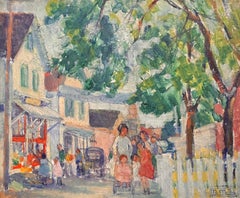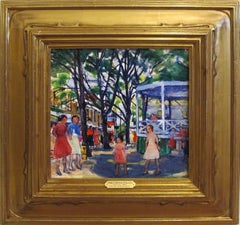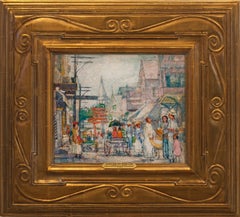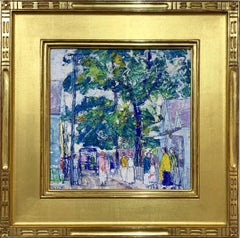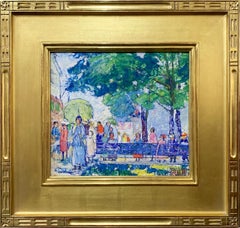Nancy Ferguson
Early 20th Century American Impressionist Figurative Paintings
Oil
1910s Abstract Impressionist Landscape Paintings
Oil, Board
1910s Abstract Impressionist Figurative Paintings
Oil, Canvas
Early 20th Century American Impressionist Landscape Paintings
Oil, Panel
Recent Sales
Early 20th Century American Impressionist Landscape Paintings
Oil, Board
Early 20th Century American Impressionist Landscape Paintings
Oil, Board
People Also Browsed
21st Century and Contemporary Italian Pillows and Throws
Velvet
Antique Early 19th Century English George IV Fireplaces and Mantels
Brass
Antique Early 1800s Georgian Console Tables
Mahogany
19th Century Landscape Paintings
Canvas, Oil
19th Century Landscape Paintings
Canvas, Oil
Antique Late 19th Century American Bookcases
Glass, Mahogany
Late 19th Century Victorian Landscape Paintings
Oil, Canvas
19th Century Landscape Paintings
Canvas, Oil
Late 20th Century American Mid-Century Modern Andirons
Brass, Iron
1910s Impressionist Landscape Paintings
Canvas, Oil
Mid-19th Century Realist Landscape Paintings
Oil
19th Century Victorian Landscape Paintings
Oil
Antique Early 1900s American Art Nouveau Table Lamps
Bronze
Vintage 1930s Swedish Gustavian Loveseats
Birch
21st Century and Contemporary French Art Deco Wall Mirrors
Bronze
20th Century American Hollywood Regency Sunburst Mirrors
Gold Leaf
Nancy Maybin Ferguson for sale on 1stDibs
A native Philadelphian, Nancy Ferguson was a highly regarded member of The Philadelphia Ten. After graduating from Philadelphia High School for Girls, she embarked on a rewarding period of study, first at the Philadelphia School of Design for Women under Elliot Daingerfield, and then at the Pennsylvania Academy of the Fine Arts under Chase, Breckenridge, Hawthorne, Carles and McCarter. She won an impressive five fellowships including the coveted Cresson Traveling Scholarship for travel abroad from the Academy in 1909. While her permanent residence was in Philadelphia, she fell in love with the picturesque village of Provincetown, Massachusetts, where her former teacher, Charles Hawthorne conducted a summer school. For most of her adult life, she divided her time between the two locations. She preferred to paint street scenes portraying a lot of activity. Her Philadelphia scenes of Rittenhouse Square and Fairmont Park are well known as are her many views in and around Provincetown. Ferguson’s earlier work is often compared to that of Maurice Prendergast. In fact, Dr. Albert Barnes purchased one of her works for his collection and used it for comparison to Prendergast in his art appreciation course. Today, it remains in the permanent collection of the Barnes Foundation. Her later works from the mid-1920s and 1930s take on a more Modernist style. These usually depict the tightly clustered architecture, winding roads and crowded harbors of Provincetown. In addition to exhibiting with The Philadelphia Ten (1923–27, 1930–38), Ferguson was invited to exhibit at many prestigious salons, including the Pennsylvania Academy of Fine Arts, the Corcoran Gallery of Art, the Philadelphia Sketch Club, the National Association of Women Painters and Sculptors, the Woodmere Art Gallery, the Philadelphia School of Design for Women, the National Academy of Design, the Carnegie Institute, the Art Institute of Chicago and the Paris Salon, among others.
Finding the Right Landscape-paintings for You
It could be argued that cave walls were the canvases for the world’s first landscape paintings, which depict and elevate natural scenery through art, but there is a richer history to consider.
The Netherlands was home to landscapes as a major theme in painting as early as the 1500s, and ink-on-silk paintings in China featured mountains and large bodies of water as far back as the third century. Greeks created vast wall paintings that depicted landscapes and grandiose garden scenes, while in the late 15th century and early 16th century, landscapes were increasingly the subject of watercolor works by the likes of Leonardo da Vinci and Fra Bartolomeo.
The popularity of religious paintings eventually declined altogether, and by the early 19th century, painters of classical landscapes took to painting out-of-doors (plein-air painting). Paintings of natural scenery were increasingly realistic but romanticized too. Into the 20th century, landscapes remained a major theme for many artists, and while the term “landscape painting” may call to mind images of lush, grassy fields and open seascapes, the genre is characterized by more variety, colors and diverse styles than you may think. Painters working in the photorealist style of landscape painting, for example, seek to create works so lifelike that you may confuse their paint for camera pixels. But if you’re shopping for art to outfit an important room, the work needs to be something with a bit of gravitas (and the right frame is important, too).
Adding a landscape painting to your home can introduce peace and serenity within the confines of your own space. (Some may think of it as an aspirational window of sorts rather than a canvas.) Abstract landscape paintings by the likes of Korean painter Seungyoon Choi or Georgia-based artist Katherine Sandoz, on the other hand, bring pops of color and movement into a room. These landscapes refuse to serve as a background. Elsewhere, Adam Straus’s technology-inspired paintings highlight how our extreme involvement with our devices has removed us from the glory of the world around us. Influenced by modern life and steeped in social commentary, Straus’s landscape paintings make us see our surroundings anew.
Whether you’re seeking works by the world’s most notable names or those authored by underground legends, find a vast collection of landscape paintings on 1stDibs.
